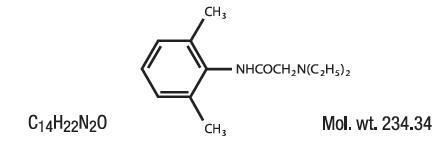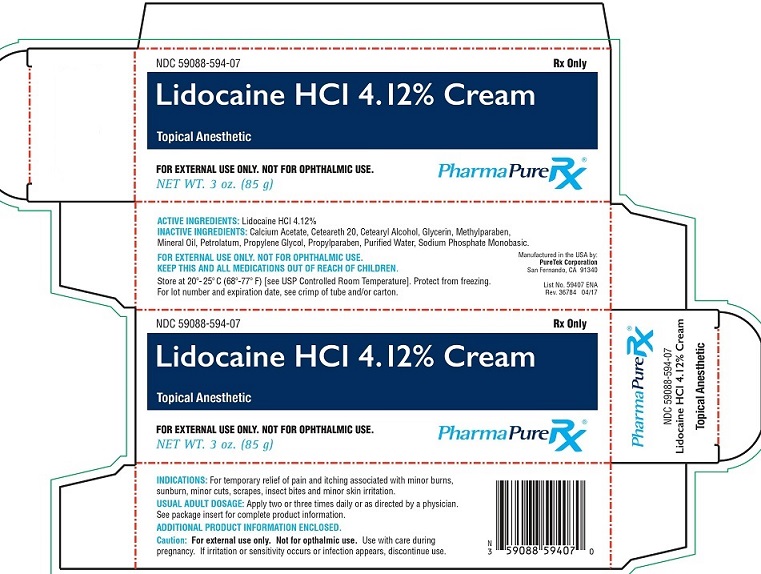PHARMAPURERX LIDOCAINE HCL 4.12%- lidocaine hydrochloride cream
PharmapureRx Lidocaine HCl 4.12% by
Drug Labeling and Warnings
PharmapureRx Lidocaine HCl 4.12% by is a Prescription medication manufactured, distributed, or labeled by PureTek Corporation. Drug facts, warnings, and ingredients follow.
Drug Details [pdf]
-
DESCRIPTION
Contains lidocaine HCl 4.12% in a mild acidic vehicle. Lidocaine is chemically designated as acetamide, 2-(diethylamino)-N-(2,6-dimethylphenyl), and has the following structure:

Ingredients: Each gram of PharmaPureRx® Lidocaine 4.12% Cream contains Lidocaine HCl USP 4.12%. Inactive Ingredients include: Calcium Acetate, Ceteareth 20, Cetearyl Alcohol, Glycerin, Methylparaben, Mineral Oil, Petrolatum, Propylene Glycol, Propylparaben, Purified Water, Sodium Phosphate Monobasic.
-
CLINICAL PHARMACOLOGY
Mechanism of Action: PharmaPureRx® Lidocaine 4.12% Cream releases lidocaine from a mild acidic vehicle to stabilize the neuronal membrane by inhibiting the ionic fluxes required for initiation and conduction of impulses, thereby effecting local anesthetic action. A mild acidic vehicle lowers pH to increase protection against alkaline irritations and to provide a favorable environment for healing.
Pharmacokinetics: Lidocaine may be absorbed following topical administration to mucous membranes, its rate and extent of absorption depending upon the specific site of application, duration of exposure, concentration, and total dosage. In general, the rate of absorption of local anesthetic agents following topical application occurs most rapidly after intratracheal administration. Lidocaine is also well-absorbed from the gastrointestinal tract, but little intact drug appears in the circulation because of biotransformation of the liver.
Lidocaine is metabolized rapidly by the liver, and metabolites and unchanged drug are excreted by the kidneys. Biotransformation includes oxidative N-dealkylation, ring hydroxylation, cleavage of the amide linkage, and conjungation. N-dealkylation, a major pathway of biotransformation, yields the metabolites monoethylglycinexylidide and glycinexlidide. The pharmacological/toxicological actions of these metabolites are similar to, but less potent than, those of lidocaine. Approximately 90% of lidocaine administered is excreted in the form of various metabolites and less than 10% is excreted unchanged. The primary metabolite in urine is a conjugate of 4-hydroxy-2, 6-dimethylaniline. The plasma binding of lidocaine is dependent on drug concentration and the fraction bound decreases with increasing concentration. At concentration of 1 to 4 g of free base per mL, 60 to 80 percent of lidocaine is protein bound. Binding is also dependent on the plasma concentration of the alpha-1-acid-glycoprotein. Lidocaine crosses the blood-brain and placental barriers, presumably by passive diffusion. Studies of lidocaine metabolism following intravenous bolus injections have shown that the elimination half-life of this agent is typically 1.5 to 2 hours. Because of the rapid rate at which lidocaine is metabolized, any condition that affects liver function may alter lidocaine kinetics. The half-life may be prolonged two-fold or more in patients with liver dysfunction. Renal dysfunction does not affect lidocaine kinetics but may increase the accumulation of metabolites. Factors such as acidosis and the use of CNS stimulants and depressants affect the CNS levels of lidocaine required to produce overt systemic effects. Objective adverse manifestations become increasingly apparent with increasing venous plasma levels above 6 g free base per mL. In the rhesus monkey, arterial blood levels of 18-21 g/mL have been shown to be threshold for convulsive activity.
- INDICATIONS
- CONTRAINDICATIONS
- WARNINGS
-
PRECAUTIONS
If irritation or sensitivity occurs or infection appears, discontinue use and institute appropriate therapy. PharmaPureRx® Lidocaine HCl 4.12% Cream should be used with caution in ill, elderly, debilitated patients and children who may be more sensitive to the systemic effects of lidocaine.
CARCINOGENESIS, MUTAGENESIS AND IMPAIRMENT OF FERTILITY: Studies of lidocaine in animals to evaluate the carcinogenic and mutagenic potential of the effect on fertility have not been conducted.
USE IN PREGNANCY: Teratogenic Effects; Pregnancy Category B. Reproduction studies have been performed for lidocaine in rats at doses up to 6.6 times the human dose and have revealed no evidence of harm to the fetus caused by lidocaine. There are, however, no adequate and well-controlled studies in pregnant women. Animal reproduction studies are not always predictive of human response. General consideration should be given to this fact before administering lidocaine to women of childbearing potential, especially during early pregnancy when maximum organogenesis takes place.
NURSINIG MOTHERS: It is not known whether this drug is excreted in human milk. Because many drugs are excreted in human milk, caution should be exercised when this drug is administered to a nursing mother.
PEDIATRIC USE: Dosage in pediatric patients would be reduced commensurate with age, body weight and physical condition.
- ADVERSE REACTIONS
- DOSAGE AND ADMINISTRATION
-
HOW SUPPLIED
PharmaPureRx® Lidocaine HCl 4.12% Cream
1 oz. (28.3 g) tube - NDC: 59088-594-03
3 oz. (85 g) tube - NDC: 59088-371-07 - STORAGE AND HANDLING
- PRINCIPAL DISPLAY
-
INGREDIENTS AND APPEARANCE
PHARMAPURERX LIDOCAINE HCL 4.12%
lidocaine hydrochloride creamProduct Information Product Type HUMAN PRESCRIPTION DRUG Item Code (Source) NDC: 59088-594 Route of Administration TOPICAL Active Ingredient/Active Moiety Ingredient Name Basis of Strength Strength LIDOCAINE HYDROCHLORIDE (UNII: V13007Z41A) (LIDOCAINE - UNII:98PI200987) LIDOCAINE HYDROCHLORIDE ANHYDROUS 41.2 mg in 1 g Inactive Ingredients Ingredient Name Strength CALCIUM ACETATE (UNII: Y882YXF34X) POLYOXYL 20 CETOSTEARYL ETHER (UNII: YRC528SWUY) CETOSTEARYL ALCOHOL (UNII: 2DMT128M1S) GLYCERIN (UNII: PDC6A3C0OX) METHYLPARABEN (UNII: A2I8C7HI9T) MINERAL OIL (UNII: T5L8T28FGP) PETROLATUM (UNII: 4T6H12BN9U) PROPYLENE GLYCOL (UNII: 6DC9Q167V3) PROPYLPARABEN (UNII: Z8IX2SC1OH) WATER (UNII: 059QF0KO0R) SODIUM PHOSPHATE, MONOBASIC, ANHYDROUS (UNII: KH7I04HPUU) Packaging # Item Code Package Description Marketing Start Date Marketing End Date 1 NDC: 59088-594-03 1 in 1 CARTON 10/02/2017 1 28.3 g in 1 TUBE; Type 0: Not a Combination Product 2 NDC: 59088-594-07 1 in 1 CARTON 10/02/2017 2 85 g in 1 TUBE; Type 0: Not a Combination Product Marketing Information Marketing Category Application Number or Monograph Citation Marketing Start Date Marketing End Date unapproved drug other 10/02/2017 Labeler - PureTek Corporation (785961046)
© 2025 FDA.report
This site is not affiliated with or endorsed by the FDA.
